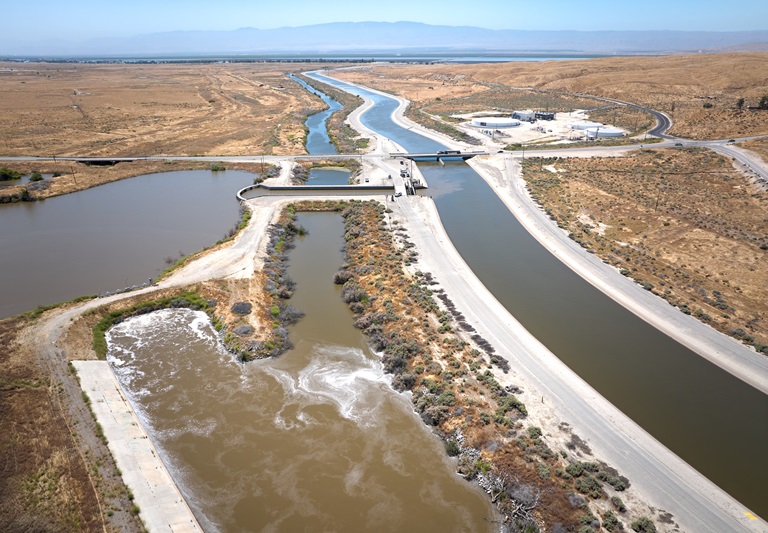DWR Captures and Stores Water from Record-Breaking Snowpack
A view from a drone of water from the Kern River Intertie flows into the California Aqueduct (on right) near the Buena Vista Fishing Site in Bakersfield, California on May 24, 2023. 
2023 has demonstrated how quickly California can move from one extreme to another -- as severe drought conditions gave way to flooding and one of the largest snowpacks in 70 years. Because of this extreme variability, and in an effort to always be climate ready, DWR and partners proactively worked to take advantage of this year’s record-breaking precipitation and prepare for the next drought. Governor Newsom’s Executive Orders this year allowed DWR to quickly manage snowmelt runoff and leverage it for increased storage in reservoirs, groundwater recharge, and water transfers.
State Water Project Moves and Stores 3.5 Million Acre-Feet of Water
California reservoirs have benefited from the historic rain and snow this past winter. DWR worked throughout the winter and spring to maximize the capture and storage of this abundant precipitation. Since Dec. 1, 2022, the State Water Project (SWP) captured a total of 3.5 million acre-feet in SWP reservoirs, and saw the greatest increase in Lake Oroville storage in the project’s history. Because California saw such extreme precipitation levels, SWP allocations were able to increase at different stages in the year. In March, DWR announced a 75 percent allocation for SWP deliveries. In April, DWR announced a 100 percent allocation for SWP deliveries for the first time since 2006.
The wet winter and strong runoff conditions have allowed the SWP to make an additional 400,000 acre-feet of water available to any contractor that can store the water in its own system, including through groundwater recharge. DWR is capturing and moving as much water as possible within the system to fill SWP reservoirs, while still meeting environmental guidelines and fulfilling water delivery needs.
Despite record-breaking precipitation this winter, California’s extremely variable climate means the next drought could always be around the corner. By proactively working with local governments to store and divert water in wet years, DWR is building a more climate-ready California that not only adapts but is resilient against increasing extremes like drought and flood.
Groundwater Recharge
The State took swift action this year to support local agencies diverting an unprecedented amount of flood water away from vulnerable communities for groundwater recharge. Diversions from high flow rivers into groundwater basins is providing immense benefit to communities, agriculture, and the environment, as well as protecting communities downstream from flooding.
DWR proactively facilitated targeted outreach to key areas in the San Joaquin Valley groundwater basins, assisting with planning and coordination between local groundwater managers, irrigation districts and landowners who can inundate open or working lands to maximize recharge. Additionally, DWR’s assistance included supporting locals with flood diversion equipment through an emergency pump program, as well as clearing lands to spread floodwaters.
While there’s limited data available on statewide groundwater recharge right now, DWR has determined an estimated 3.8 million acre-feet of water has been recharged so far this year. For perspective, the goal from the Newsom Administration’s Water Supply Strategy is to increase groundwater recharge capacity by an average of 500,000 acre-feet per year.
As a result of the Governor’s Executive Orders, a total of 92,410 acre-feet of potential flood waters have been diverted to protect communities and for groundwater recharge for future use statewide.
DWR will have a full picture of the 2023 water year groundwater conditions after April 1, 2024, when Annual Reports are due from the local groundwater sustainability agencies. These annual reports are publicly available on the SGMA Portal.
Water Transfers/Tulare Lake
Through DWR’s Temporary Flood Diversion Equipment and Recharge Enhancement efforts, DWR supplied temporary pumps and equipment along the Kings and the Kaweah high-flow rivers in the Tulare Lake basin to divert floodwater off these rivers before it reached the lakebed, simultaneously reducing flood impacts in the lakebed and recharging depleted groundwater basins. Local agencies have been able to divert an estimated 20,517 acre-feet of floodwater for recharge in the Tulare Lake region from late April to late June.
In total, 41,982 acre-feet of water was diverted from Tulare Lake for recharge through state assistance and under the of Governor’s Floodwater Executive Order. This estimate increases to 66,692 acre-feet when you include the amount of water diverted via the Kern River Intertie. A total of 24,710-acre feet of flood flows was redirected from the Kern River to the California Aqueduct starting in late-May through mid-June.
View Governor Newsom’s winter storms-related Executive Orders:
